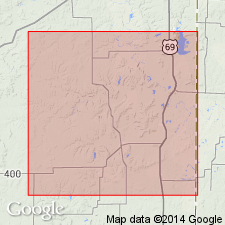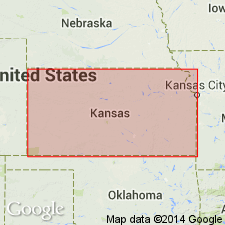
- Usage in publication:
-
- Hepler sandstone
- Modifications:
-
- Original reference
- Dominant lithology:
-
- Sandstone
- AAPG geologic province:
-
- Cherokee basin
- Forest City basin
Summary:
Pg. 8-9, fig. 2. Hepler sandstone. A persistent sandstone, at base of Bourbon group generally not more than 3 or 4 feet thick but as much as 20 feet thick north of Pleasanton, Linn County, eastern Kansas, where it is asphalt bearing. Conformably underlies gray, yellow, and black shale; disconformably overlies upper layers of Marmaton group. Columnar section shows the Hepler overlying Memorial shale. Age is Late Pennsylvanian (Missourian).
Type exposure: in center sec. 14, T. 27 S., R. 22 E., 1.5 mi north of Hepler, Bourbon Co., eastern KS.
Source: US geologic names lexicon (USGS Bull. 1200, p. 1736-1737).

- Usage in publication:
-
- Hepler sandstone
- Modifications:
-
- Revised
- AAPG geologic province:
-
- Cherokee basin
- Forest City basin
Summary:
Pg. 73; R.C. Moore and others, 1951, Kansas Geol. Survey Bull., no. 89, p. 91. Hepler sandstone. Reallocated to Pleasanton group which replaces Bourbon group (suppressed).
Source: US geologic names lexicon (USGS Bull. 1200, p. 1736-1737).
For more information, please contact Nancy Stamm, Geologic Names Committee Secretary.
Asterisk (*) indicates published by U.S. Geological Survey authors.
"No current usage" (†) implies that a name has been abandoned or has fallen into disuse. Former usage and, if known, replacement name given in parentheses ( ).
Slash (/) indicates name conflicts with nomenclatural guidelines (CSN, 1933; ACSN, 1961, 1970; NACSN, 1983, 2005, 2021). May be explained within brackets ([ ]).

